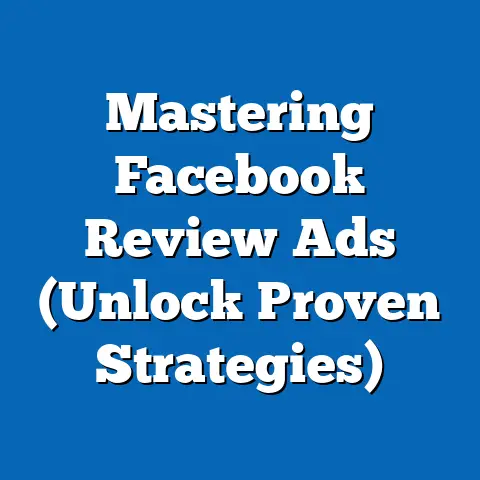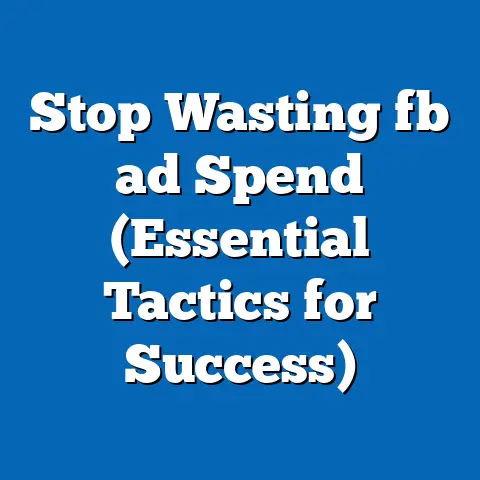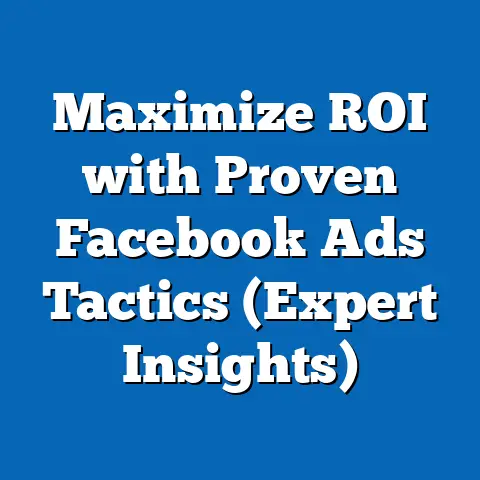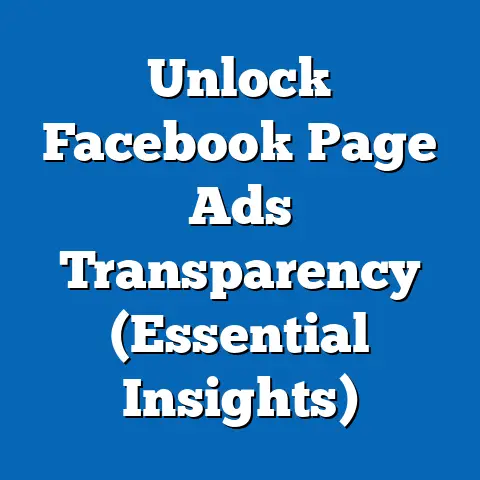Unlocking Facebook Ads Library Secrets (Proven Strategies)
I’ve always been fascinated by the intersection of technology and sustainability. In today’s world, businesses are increasingly recognizing the importance of eco-friendly practices, and this shift is profoundly impacting how they advertise. As a digital marketing specialist, I’ve seen firsthand how eco-tech brands are leveraging platforms like Facebook to showcase their commitment to sustainability and connect with environmentally conscious consumers.
The Facebook Ads Library is a game-changer for marketers in any niche, but it’s particularly valuable for those in the eco-tech space. It offers unprecedented transparency, allowing you to see exactly what ads are running, who’s running them, and how they’re being targeted. This information is gold! By understanding trends, competitor strategies, and successful ad formats, you can craft more effective campaigns that resonate with your audience and drive meaningful results.
In this guide, I’ll share my proven strategies for unlocking the secrets of the Facebook Ads Library and using it to supercharge your eco-tech advertising efforts. We’ll dive deep into analyzing competitor ads, crafting your own impactful campaigns, and optimizing for peak performance. Let’s get started!
Section 1: Understanding the Facebook Ads Library
So, what exactly is the Facebook Ads Library? Simply put, it’s a public, searchable database of all ads currently running on Facebook and Instagram. Think of it as a behind-the-scenes look at the advertising strategies of businesses around the world.
The primary purpose of the Ads Library is to promote transparency in advertising. Before its launch, it was difficult to track political advertising and understand the messages being spread. Now, anyone can see who is paying for what ads, regardless of whether they are political or commercial.
Here’s a breakdown of its key features:
- Search Functionality: You can search for ads using keywords, advertiser names, or categories. This makes it easy to find ads related to specific products, services, or industries.
- Filtering Options: You can filter ads by country, platform (Facebook, Instagram, etc.), and ad category (e.g., all ads, political ads).
- Ad Details: For each ad, you can see the ad copy, visuals, targeting information (e.g., age, gender, location), and dates the ad ran.
- Reporting: The Ads Library also provides reports on political and issue-based advertising spend, offering insights into trends and patterns.
Why is this important, especially for eco-tech brands?
Trust and credibility are paramount in the eco-tech sector. Consumers are increasingly discerning and want to support brands that genuinely align with their values. By being transparent about your advertising, you can build trust with your audience and demonstrate your commitment to sustainability. The Ads Library allows potential customers to verify your claims and see how you’re communicating your eco-friendly message.
Takeaway: The Facebook Ads Library is a powerful tool for understanding the advertising landscape and building trust with your audience. Familiarize yourself with its features and start exploring!
Section 2: Analyzing Competitor Ads
One of the most valuable uses of the Facebook Ads Library is analyzing your competitors. By seeing what ads they’re running, how they’re targeting their audience, and what messaging they’re using, you can gain valuable insights that inform your own strategy.
Here’s how to use the Ads Library for competitor analysis:
- Identify Your Competitors: Start by creating a list of your main competitors in the eco-tech space. These could be direct competitors offering similar products or services, or indirect competitors targeting the same audience with different solutions.
- Search for Their Ads: In the Ads Library, search for each competitor by name. This will pull up all the ads they are currently running on Facebook and Instagram.
- Examine Ad Copy and Visuals: Pay close attention to the language and imagery they are using. What kind of message are they conveying? What problems are they addressing? How are they positioning their brand?
- Analyze Targeting Information: While the Ads Library doesn’t provide exact targeting details, it does show you the age, gender, and location of the audience being targeted. This can give you clues about their ideal customer profile.
- Assess Call-to-Actions: What actions are they encouraging users to take? Are they driving traffic to their website, promoting a specific product, or encouraging sign-ups?
- Categorize and Analyze: Organize the ads you find into categories based on product type, messaging, target audience, and call-to-action. Look for patterns and trends. What types of ads seem to be most common? What approaches are they using repeatedly?
- Pay Attention to Engagement: While the Ads Library doesn’t show specific engagement metrics (likes, comments, shares), you can get a sense of an ad’s effectiveness by looking at how long it’s been running. Ads that have been running for a long time are likely performing well.
Examples of Eco-Tech Brands Leveraging the Facebook Ads Library:
While I can’t name specific brands due to privacy concerns, I’ve observed several successful eco-tech brands using the Ads Library to their advantage. For example, one company selling solar panels consistently runs ads highlighting the cost savings and environmental benefits of their product. They use compelling visuals of homes powered by solar energy and target homeowners in specific geographic areas.
Another brand selling sustainable clothing focuses on the ethical and environmental aspects of their production process. Their ads feature images of their factories and the artisans who create their garments, emphasizing fair labor practices and eco-friendly materials.
Key Insights from Competitor Analysis:
- Identify Gaps in the Market: Are there any underserved segments of the audience or unmet needs that your competitors are not addressing?
- Refine Your Messaging: How can you differentiate your brand and communicate your unique value proposition more effectively?
- Improve Your Targeting: Are you reaching the right audience with your ads? Can you narrow your focus to target specific demographics or interests?
- Optimize Your Creative: Are your visuals and ad copy compelling enough to capture attention and drive engagement?
Takeaway: Competitor analysis is crucial for staying ahead of the curve in the eco-tech space. Use the Facebook Ads Library to gain insights into your competitors’ strategies and identify opportunities to improve your own campaigns.
Section 3: Crafting Your Own Eco-Tech Ads
Now that you’ve analyzed your competitors, it’s time to craft your own impactful Facebook ads. Creating effective ads for eco-tech brands requires a nuanced approach that combines compelling storytelling with a genuine commitment to sustainability.
Here are some proven strategies for creating eco-tech ads that resonate:
- Align with Eco-Friendly Values: Your ads should clearly communicate your brand’s commitment to sustainability. Highlight the eco-friendly aspects of your products or services, such as the use of recycled materials, reduced carbon footprint, or support for environmental initiatives.
- Tell a Story: Consumers are more likely to connect with brands that tell a compelling story. Share the story behind your brand, your mission, and the impact you’re making on the environment.
- Use Compelling Visuals: Choose visuals that resonate with environmentally conscious consumers. This could include images of nature, sustainable products, or people engaged in eco-friendly activities. Avoid using stock photos that look generic or inauthentic.
- Be Transparent: Be honest and transparent about your environmental practices. Don’t make exaggerated claims or engage in greenwashing. If you’re not perfect, acknowledge your shortcomings and explain what you’re doing to improve.
- Focus on Benefits: While it’s important to highlight the environmental benefits of your products or services, also focus on the practical benefits for consumers. This could include cost savings, improved performance, or enhanced convenience.
- Use Clear and Persuasive Calls-to-Action: Tell users exactly what you want them to do. Use clear and concise calls-to-action, such as “Learn More,” “Shop Now,” or “Sign Up for Our Newsletter.”
- Target the Right Audience: Use Facebook’s targeting options to reach consumers who are interested in sustainability, environmental issues, and eco-friendly products. This could include targeting users who follow environmental organizations, participate in eco-friendly activities, or have expressed interest in sustainable living.
Examples of Effective Eco-Tech Ad Messaging:
- Focus on Impact: “Reduce your carbon footprint with our energy-efficient appliances. Save money and help the planet!”
- Highlight Sustainability: “Our clothing is made from recycled materials and ethically sourced. Look good and feel good about your purchase.”
- Promote Innovation: “Introducing the world’s first biodegradable phone case. Protect your phone and protect the environment.”
- Emphasize Community: “Join our community of eco-conscious consumers. Together, we can make a difference.”
Takeaway: Crafting effective eco-tech ads requires a genuine commitment to sustainability, compelling storytelling, and targeted messaging. Focus on aligning your ads with eco-friendly values, using compelling visuals, and providing clear calls-to-action.
Section 4: Optimizing Ad Performance
Creating great ads is only half the battle. To truly succeed with Facebook advertising, you need to continuously optimize your campaigns for peak performance. This involves tracking your results, analyzing your data, and making adjustments based on what you learn.
Here are some key techniques for optimizing your eco-tech ads:
- Track Your Key Metrics: Monitor your ad performance closely. Pay attention to metrics such as impressions, reach, clicks, click-through rate (CTR), conversion rate, and cost per acquisition (CPA).
- Use Facebook Insights: Facebook Insights provides detailed information about your audience, including their demographics, interests, and behaviors. Use this data to refine your targeting and create more relevant ads.
- A/B Test Your Ads: Experiment with different ad variations to see what works best. Test different headlines, visuals, ad copy, and calls-to-action.
- Adjust Your Targeting: Continuously refine your targeting to reach the right audience. Experiment with different demographics, interests, and behaviors.
- Optimize Your Bidding Strategy: Use Facebook’s bidding options to optimize your ad spend. Experiment with different bidding strategies to see which one delivers the best results.
- Monitor Ad Frequency: Pay attention to ad frequency, which is the average number of times a user sees your ad. If your frequency is too high, users may become annoyed and your ad performance may suffer.
- Use Retargeting: Retargeting allows you to show ads to users who have previously interacted with your brand. This is a highly effective way to drive conversions and increase sales.
- Leverage the Ads Library: Revisit the Ads Library periodically to see what your competitors are doing. Are they running new ads? Are they changing their messaging or targeting? Use this information to inform your own strategy.
Examples of Successful Optimization Strategies:
One eco-tech brand selling reusable water bottles found that their initial ads were not performing as well as expected. After analyzing their data, they discovered that their target audience was primarily interested in outdoor activities and fitness. They then created new ads featuring images of people using their water bottles while hiking and running. These ads performed significantly better, resulting in a higher click-through rate and lower cost per acquisition.
Another brand selling solar panels found that their ads were generating a lot of leads, but few of those leads were converting into sales. After further investigation, they discovered that their sales team was not effectively following up with leads. They then implemented a new sales process that included timely follow-up and personalized communication. This resulted in a significant increase in sales conversions.
Takeaway: Optimizing your Facebook ads is an ongoing process. Continuously track your results, analyze your data, and make adjustments based on what you learn. A/B testing, refining your targeting, and optimizing your bidding strategy are all crucial for maximizing your ad performance.
Conclusion
The Facebook Ads Library is an invaluable tool for eco-tech marketers looking to understand the competitive landscape, craft compelling ads, and optimize for peak performance. By taking advantage of the insights and strategies discussed in this guide, you can enhance your advertising efforts, promote eco-friendly practices, and achieve your marketing goals.
Remember, success in Facebook advertising requires a genuine commitment to sustainability, compelling storytelling, and continuous optimization. By understanding your audience, crafting thoughtful ads, and tracking your results, you can build a successful brand and make a positive impact on the environment.
Now go forth and unlock the secrets of the Facebook Ads Library! Your journey to eco-tech advertising success starts now.






